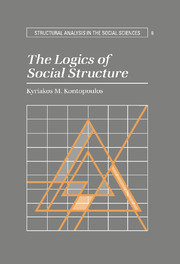Book contents
- Frontmatter
- Contents
- Preface
- Introduction
- Part I Metatheoretical considerations
- 1 Epistemic strategies in contemporary science
- 2 The dynamics of emergence: the case against reductionism
- 3 The nature of hierarchical and heterarchical organization
- 4 Some formal theses on hierarchy and heterarchy
- Part II Compositionist logics
- Part III Logics of hierarchy
- Part IV Heteracrchical logics
- Part V The phenomenology of social structures
- Appendix: The logics of structuration
- Glossary
- Bibliography
- Index
4 - Some formal theses on hierarchy and heterarchy
Published online by Cambridge University Press: 24 October 2009
- Frontmatter
- Contents
- Preface
- Introduction
- Part I Metatheoretical considerations
- 1 Epistemic strategies in contemporary science
- 2 The dynamics of emergence: the case against reductionism
- 3 The nature of hierarchical and heterarchical organization
- 4 Some formal theses on hierarchy and heterarchy
- Part II Compositionist logics
- Part III Logics of hierarchy
- Part IV Heteracrchical logics
- Part V The phenomenology of social structures
- Appendix: The logics of structuration
- Glossary
- Bibliography
- Index
Summary
Our general discussion in the previous chapter has not yet prepared us sufficiently to enter the domain of social phenomena and spell out the basic characteristics of the competing epistemic strategies (or logics) of social structure. We still need to define the specific characteristics of hierarchies and heterarchies in a more detailed fashion; this will help us considerably later on, when we will attempt to articulate the contours of the relevant compositionist, hierarchical, and heterarchical theories of structural emergence in the social field.
The teleomatic, the teleonomic, the teleological
We begin, in a roundabout fashion, by offering a classification of various types of systems or structures – physical, biological, and socio-cognitive – following the suggestion of the biologist Ernst Mayr and of various other evolutionists after him (see also the last part of Chapter 8). Mayr describes in the form of a hierarchy three types of processes beyond the intuitively bottom level of physical existence (Aristotle's material cause). All three involve forward-directed processes. He calls them teleomatic, teleonomic, and teleological.
Teleomatic processes are those that reach deterministically predictable end-states through ordinary physical processes (end-resulting; involving Aristotle's efficient cause). Mayr distinguishes two subcategories: mechanistic-causal and thermodynamic-statistical. Mechanistic processes obey the basic laws of nature, such as gravity. Thermodynamic processes – essentially of the nonequilibrium thermodynamic (NET) variety – obey the laws of entropy and dissipation and explain the occurrence of irreversible processes.
- Type
- Chapter
- Information
- The Logics of Social Structure , pp. 59 - 72Publisher: Cambridge University PressPrint publication year: 1993



